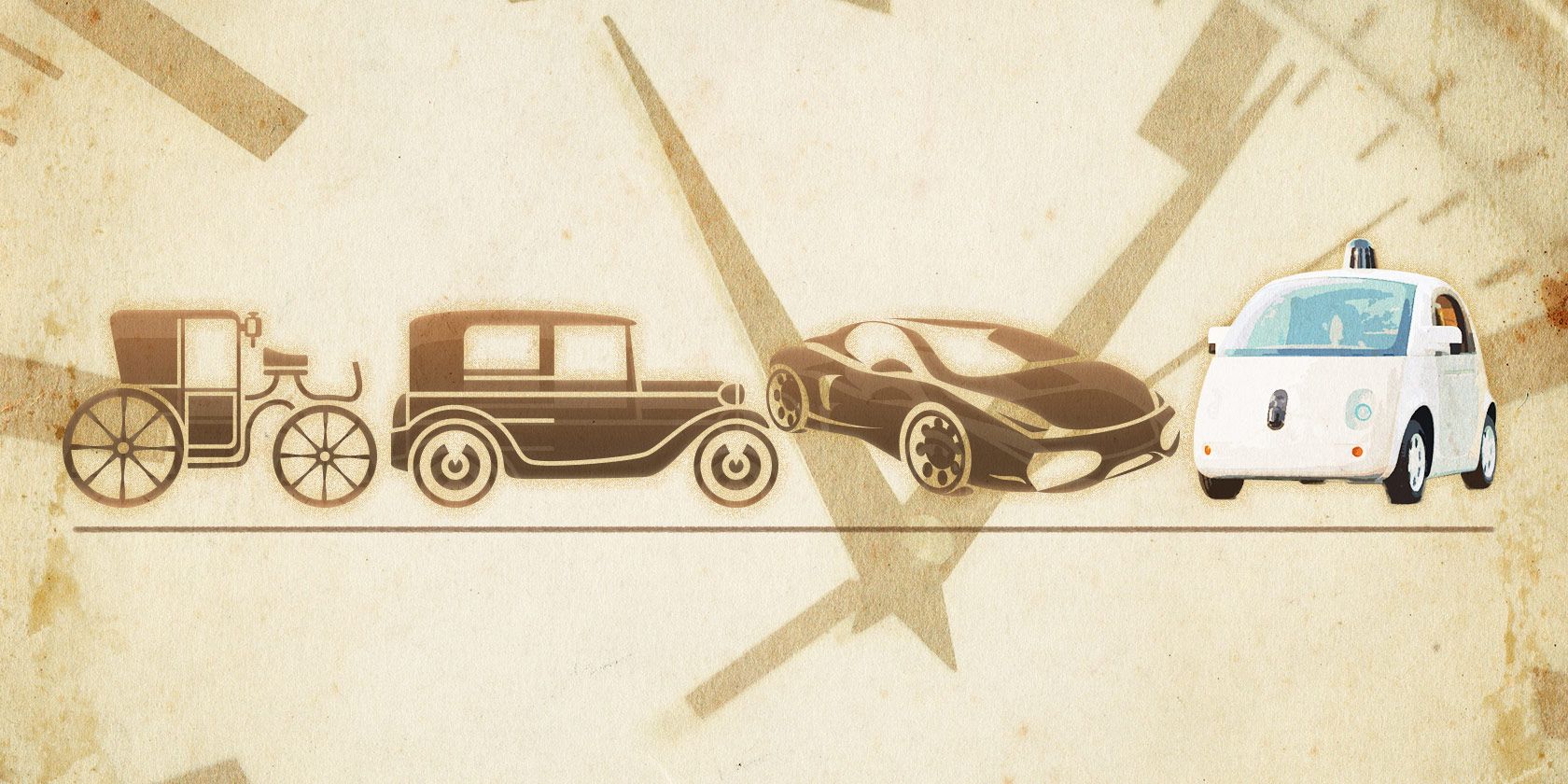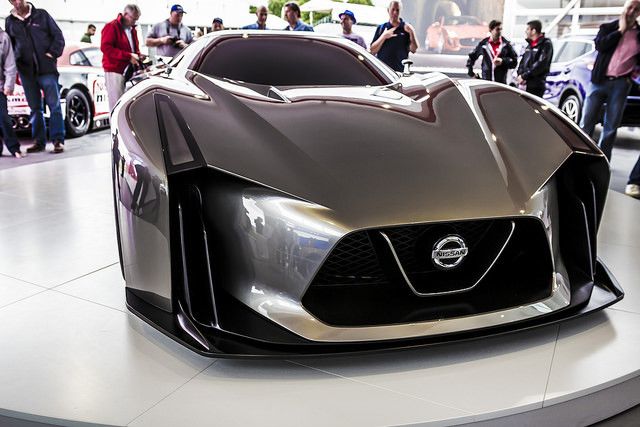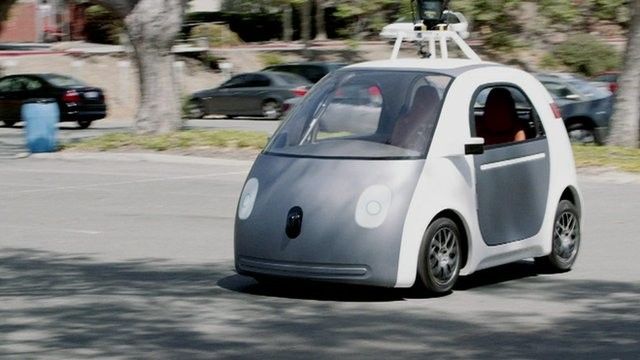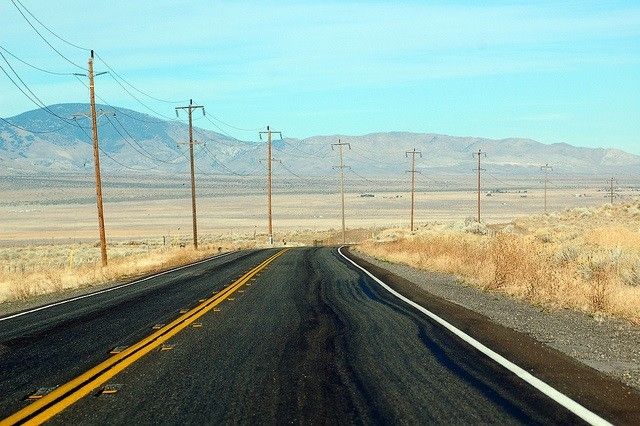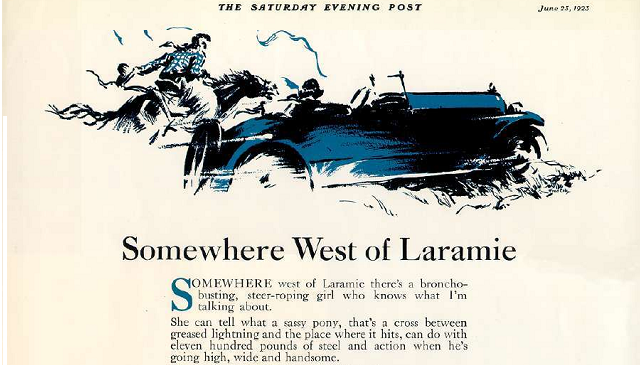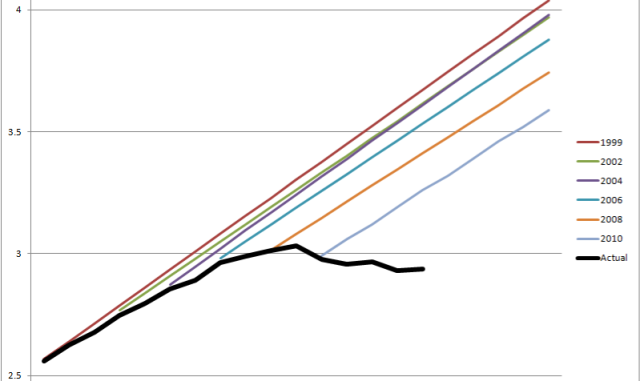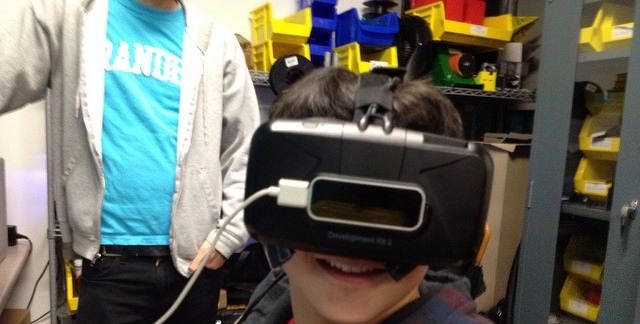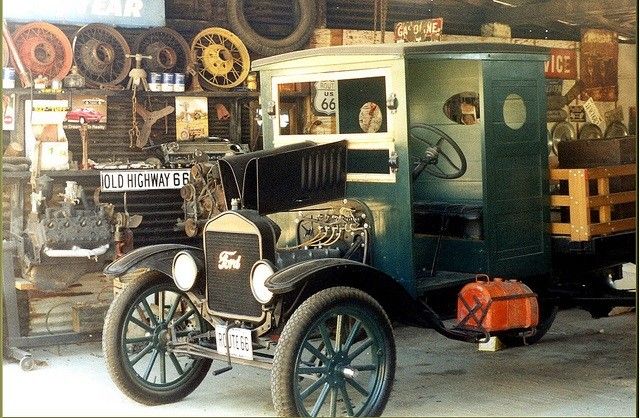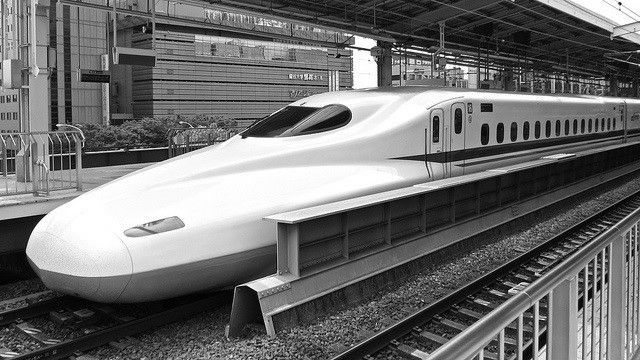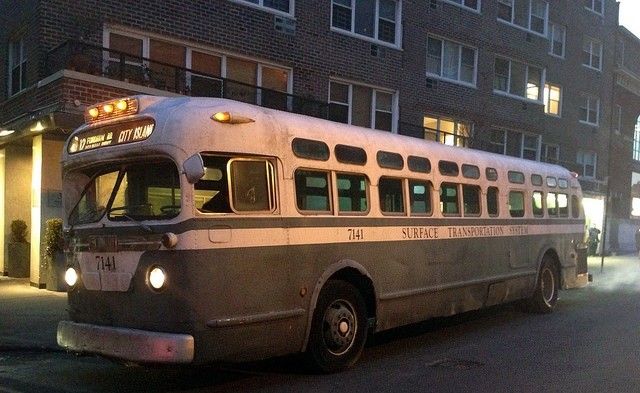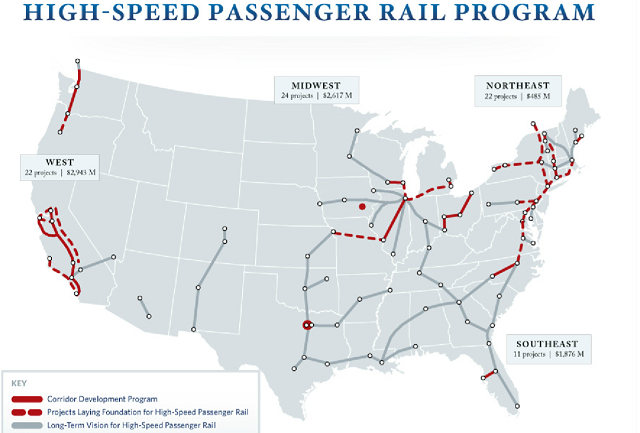"History is more or less bunk. It's tradition. We don't want tradition. We want to live in the present and the only history that is worth a tinker's damn is the history we made today."
-Henry Ford, May 25th, 1916
For years, concept cars have provided important glimpses of where the automotive industry is headed – but have you noticed that concept cars lately seem a little...out of touch?
Check out the Concept 2020, Nissan's vision of the car of the future.
Look at that thing! It looks the love child of a Cylon and a box of razor blades. It's less a car than a carbon fiber sculpture of a mid-life crisis.
And that's the problem. Concept cars, at their heart, are reflections of possible futures. Guess the future wrong, and you'll find yourself designing beautiful cars for worlds that will never exit.
Cars like the 2020 are designed to be loved. They're designed for drivers who long for the freedom of the open road and the rumble of acceleration beneath their feet; drivers who don't mind spending weekends scrubbing mud off their high-performance batmobiles.
They're designed for a future that isn't going to happen.
The modern car is the same basic product that the Ford Model T pioneered, way back in 1908. It's prettier, faster, and safer – but the core of the product hasn't changed in over a century. As Henry Ford knew, the world changes fast, and sometimes it demands something fundamentally new – a new revolution, for a new century. The real future of the car is going to look almost nothing like the 2020. The real future of the car is safe, efficient, and totally invisible. You'll know it when you see it, because it'll look a little like this:
The Rise And Fall of The American Car
In order to understand where the car is going, it's worth taking a moment to figure out how we got here. To do that, we'll have to go all the way back to 1921, when the highway system was first established.
The world was recovering from its first World War, and America had won. Rationing was over. Factories seized by the government stopped making tanks and rifles and started making cars and blenders again. The American economy was experiencing explosive growth, the likes of which the world had never seen. The boom was fueled by immigrant labor and the recent invention of the assembly line. And, for the first time, there was a network of high-speed thoroughfares connecting the whole country together – a rail network for the 20th century.
Suddenly, ordinary people found that cars, formerly luxury items, were both affordable and necessary. A man with a car could travel the nation, coast to coast, with no plan and no tickets. Ordinary people could explore the nation in ways never before possible. Cars went from an oddity to a ubiquity in a handful of decades. These days, the average American household owns more than two cars. According to DigitalHistory.com:
Cars were the symbol of the new consumer society that emerged in the 1920s. In 1919, there were just 6.7 million cars on American roads. By 1929, there were more than 27 million cars – or nearly one car for every household in the United States. [...]
The implications were far-reaching. The ability to commute changed the shape of our cities, creating the modern suburb. The road trip became a rite of passage and a cultural touchstone. Cars became the most visible expressions of wealth and conspicuous consumption. The conservative design of the Ford Model T gave way to the shining curves and purring engines of muscle cars. Even modern dating culture owes its structure to the ubiquitous car. Automobiles provided young lovers with a level of privacy and autonomy beyond the wildest dreams of their ancestors. The sexual revolution of the 1960's certainly couldn't have happened without the rise of automobiles, decades prior.
Is it any wonder that cars became a symbol of freedom? Generations of teenagers found that the world opened up to them behind the wheel of a car. There are decades worth of hit singles fixating on cars as a mark of adulthood, rebellion, and independence. Car manufacturers themselves didn't shrink from the association. As early as 1923, manufacturers were abandoning the idea of selling cars on dry, technical specs. They started running ads like this one.
Buy a car, ads promised, and you'll be sexy. Buy a car and you'll be free. Buy this car, and you'll be the person you've always wanted to be. You don't sell cars the way you sell blenders – you sell cars the way you sell Bibles.
This isn't to imply that the rise of the car was all sunshine and roses: between the ages of 10 and 24, cars are the single biggest killer of human beings. Due to growing commutes and poor urban planning, the average commuter now spends almost 40 hours a year stuck in traffic. It's quite possible that chronic lead poisoning from exhaust fumes caused the wave of violent crime wave that began in the 1960's. Cars also contribute almost 28% of world CO2 emissions. According to National Geographic's analysis,
"Vehicles are America’s biggest air quality compromisers, producing about one-third of all U.S. air pollution. The smog, carbon monoxide, and other toxins emitted by vehicles are especially troubling because they leave tailpipes at street level, where humans breathe the polluted air directly into their lungs. That can make auto emissions an even more immediate health concern than toxins emitted high in the sky by industrial smokestacks."
Still, despite all the bad, it's hard to argue that the US without the car would be scarcely recognizable. Cars have become deeply and fundamentally entangled with American culture, and they're never, ever going away.
At least, you'd think that.
Fast forward to 2015, and automakers have a problem. It looks like this:
Every year, the US Department of Transportation releases its new projection of how many miles per year Americans will drive in the future. This graph shows six of those projections (the colored lines), overlaid with what actually happened (the black line). As you can see, despite the optimism of the Department of Transportation, American driving peaked in 2008, and has been declining since then. The number of miles driven by drivers under 30 fell 25% between 2001 and 2009. This concept is ominously referred to as "peak car." From The Economist:
"[I]n the rich world the car’s previously inexorable rise is stalling. A growing body of academics cite the possibility that both car ownership and vehicle-kilometres driven may be reaching saturation in developed countries – or even be on the wane [...]
Recession and high fuel prices have markedly cut distances driven in many countries since 2008, including America, Britain, France and Sweden. But more profound and longer-run changes underlie recent trends. Most forecasts still predict that when the recovery comes, people will drive as much and in the same way as they ever have. But that may not be true."
The trend is borne out by other statistics: by all accounts, millenials are not buying cars, and many don't bother to even get a driver's license. The rate of license ownership among 16-19 year olds is now less than 50%, a historic low. Even among 20-24 year olds, only about 80% have drivers licenses as of 2010 – another all time low, and one that's falling every year.
Why Aren't Millenials Driving?
Car manufacturers are largely at a loss about how to sell to millenials. The old style of advertising doesn't seem to be working, and they aren't sure why. Every attempt to modernize advertising of cars has been an embarrassing mess, including one ill-fated attempt to leverage MTV as a platform. For years now, manufacturers have been working off of the increasingly desperate idea that millenials really do want cars, and just have to be marketed to in a sufficiently sexy way. John McFarland, GM's manager of Global Strategy, is of this viewpoint.
"I don’t believe that young buyers don’t care about owning a car. [...] We just think nobody truly understands them yet."
Despite McFarland's confidence, it's been years and the trend shows no sign of reversing. So what's going on?
As with every generation of young people, there are plenty of unkind stereotypes about millenials. Anyone will tell you that millenials are lazy, narcissistic, gadget-obsessed, and anti-social. It's not hard to tie the reduced rate of driving into these stereotypes, and plenty of lazy writers have. However, this kind of glib generational politics ignores a more fundamental change, across both culture and economics. We ignore that change at our peril. So let's take a minute and look at some broad (and non-judgmental) trends that might be contributing to the drop in car ownership.
One big factor has to be urbanization. Millenials, currently the largest generation, are flocking to cities in record numbers, and cities in general are growing. According to the US Census, "Urban areas [...] now account for 80.7 percent of the U.S. population, up from 79.0 percent in 2000." According to William Fray, a demographer with the Brookings Institute,
"At this point, the prognosis does not look good for much of small town America (with the exceptions of a handful of energy boom towns and retiree magnets). As badly as some regions have fared during the post-recession period, the new statistics show population decline in smaller areas, increasing large metropolitan area dominance."
Owning a car in a city is expensive [Broken URL Removed]: the cost of storing, fueling, and maintaining the vehicle is too high for the privilege of being stuck in traffic. Ride sharing options like Lyft and Uber provide a better experience for urbanites, as evidenced by their explosive growth. Uber alone is currently valued at more than $40 billion. Their CEO, Travis Kalanick, says consumers who are ditching their cars are among their largest growth demographics:
"Many of our customers are already in that group [...] We get customer feedback every day saying, 'Hey I just sold my car; I don't need to pay for parking at home or work.' Lets say that's $500 a month for both. We just saved them $6,000 a year. ... I think that's why so many people are using Uber and getting rid of their cars."
If we look a little further ahead, we can predict that the cities of the future will be larger, and will contain huge numbers of people who want to go places but do not own cars. The farther we go into the future, the stronger the trend becomes. In another generation (2035), everyone under the age of 50 will belong to a driving-averse demographic.
Another factor is, of course, the economy. Millenials are growing up in a less friendly job market than their parents. 15% of millenials are unemployed and the stagnant job market limits upward mobility. For cash-strapped young people, spending thousands of dollars on a car – much less a new car – isn't an option. As the economy improves, some of this trend should diminish – but that's going to be a slow process.
Maybe the most fundamental change, though, has to do with how cars are perceived. As technology improves, more and more of people's social experience winds up online. For anyone who grew up with the Internet, the first memory of freedom and independence probably wasn't their first car – it was their first PC, or phone. Millenials live their lives online, and the privacy of having your own computer may well be a much bigger deal than car ownership. Cars may also be less necessary for daily life, in a world with telecommuting, online dating, and social networks. Like the first automobiles, the PC has brought its own kind of freedom, and its own little revolutions.
Darren Ross, of FastCoExist, makes a similar point,
"Today however, older teens and young adults don't need cars to achieve a sense of self and freedom. This generation’s coming of age consisted of graduating from the Internet and CD-ROM computer games to hand-held mobile devices where they’re establishing identities, relationships, and individualism online all day long – as much as, if not more than, in the real world."
In a way, this is the scariest answer for car manufacturers: millenials don't care about cars because, at the end of the day, cars are somebody else's dream.
That trend isn't going away anytime soon, or even slowing down. The rise of social virtual reality is going to close much of the gap between real life and the Internet, enriching online conversation with the nuance of body language and facial expression, as well as the sense of physically sharing a space with another person. When you grow up with the ability to virtually teleport yourself to spend time with your friends any time you want, who is going to be rushing to the DMV on their sixteenth birthday?
The key point here is that the change in purchasing habits of young consumers isn't a tantrum or a statistical blip. This is a fundamental shift in the status quo, and it's just the tip of the iceberg. The reason the hyper-macho concept cars look out of touch is because they're being designed for consumers who are not going to exist. All of the trends today point to the consumers of the future having less car-friendly lifestyles, less money to spend on them, and less investment in car ownership as an idea. They're not going to be eager to pony up thousands of dollars for minor performance gains and a slick design.
If we accept that this is true, it raises an interesting question: if it's not the batmobile, then what are consumers of the future going to want?
The Future of The Car
The details of the future are always tough to predict, and transportation is no exception. There are a number of wildcard technologies, from Elon Musk's Hyperloop to telepresence, any of which could change the shape of things to come. We also have to remember the role played by regulators, who have the ability to crush new technologies on behalf of entrenched interests.
Still, if I had to make one bet, it would be on the transformative change that autonomous vehicles (AVs) are going to bring about in the next twenty years.
A quick recap, for those who aren't up to speed on AV technology:
- AVs are robotic vehicles which are designed to be able to navigate safely on public roads, entirely under computer control – passengers can relax, work, or browse the internet.
- Modern AVs do not require special infrastructure, and can drive using street signs and traffic signals, just like human beings. These vehicles do depend on detailed maps of their environment to function, which must be partially built by hand.
- Prototype vehicles exist right now, and have autonomously driven hundreds of thousands of miles in California without mishap.
- The most advanced AV project is Google's. Google is currently seeking partners to mass-produce the finished product.
- Existing AVs are prototypes, and not yet ready for mass adoption: they still occasionally encounter situations which require a human to take over, and they have difficulty with snow and rain. However, progress is extremely fast.
- Dozens of states and countries are gearing up to begin mass testing of AVs, and Google is funneling enormous amounts of lobbying money into streamlining the path to legalization for these devices.
- Because they don't get distracted or impatient, and can respond inhumanly quickly, AVs have the potential to be much safer than human drivers.
Modern autonomous vehicle technology dates back about ten years, to the DARPA Grand Challenge. The Grand Challenge was a two-million-dollar competition that challenged teams from companies and universities across the country to navigate an enormous desert track with an autonomous car.
http://youtu.be/uoiJeIb0wBA?t=14s
There were no finalists the first year, but progress was fast: before long several working prototypes had emerged, fueled by new technologies and clever engineers. One of those projects, "Stanley," the work of a team at Stanford University, was acquired by Google and became the basis of their current self-driving car research. Now, the technology is rapidly closing in on consumer readiness, and many observers expect it radically change the way that people move around.
Why The Future of The Car is a Robot
When most people think about 'self-driving cars', they often tend to view them as a convenience or a safety feature, like cruise control or ABS brakes. It's easy to assume that autonomous vehicles are something that free you up to watch Netflix on the way to work – cool, but not a revolution.
This is almost exactly the wrong way to think about the issue. When we talk about AVs, we're really talking about fleets: computer-controlled networks of cars which can be summoned from any mobile device. From this perspective, the advantages are a lot more visible.
We've already established that future people will be increasingly urban and driving-averse. It's not a big stretch to predict that, within a few years, most urban travel will be done using ride sharing services like Lyft and Uber. Autonomous fleets are a natural fit for these services, and once the fleets are in place, some exciting possibilities emerge. The head of Google's AV project, Chris Urmson, imagines a similar future,
"Imagine a world where you get in your car, it takes you where you want to go, and then you get out. And you don't have to search for parking. You just leave it, and it goes off and lets someone else get to where they're going."
Autonomous fleets won't just be cheaper than existing services – they'll be much cheaper. We've talked about the ecology of autonomous vehicles before, but the point is worth repeating: fleets of AVs can take advantage of powerful network effects that are not available to individual car owners.
For starters, the fleet only needs to maintain as many cars as are required during peak usage – about half the number currently in circulation, according to an extremely conservative projection. This drastically reduces the cost of operating the network, as well as eliminating the need for most of the world's parking lots, freeing that valuable land up for other purposes. Because the fleet doesn't need to be comprised of cars in the traditional sense, the network can also reduce costs by pooling rides together along the same routes, sending bigger vehicles where necessary. This is a service that Uber already offers, and it'll get much more powerful when the cars are autonomous.
AV fleets will also be well positioned to take advantage of electric car technology. Electric AVs could charge themselves when not in use, and the fleet could maintain a small number of gas cars for long trips. This allows the network to take advantage of the enormous cost benefits (both financial and ecological) of electric vehicles, without exposing users to their drawbacks. Autonomous vehicles will also be able to coordinate together for smart drafting and traffic jam avoidance, to make trips faster and more efficient.
In the long run, it may be more than an order of magnitude cheaper to travel by AV than to drive yourself, especially if you live in an urban center. That's not even mentioning the convenience, or added safety. Computers get better at driving every year; humans collectively don't. As one Google engineer puts it:
“One point two million people killed every year [by cars] and 90 plus percent of that is human error, and so if we can bring in technology that’s always paying attention, that can see what’s going on around it, that never gets distracted… that’s a huge opportunity. When self driving cars are a reality, its going to be amazing. Imagine never losing someone to a traffic accident again. [...] Imagine cities where parking garages aren’t there. […] It’s going to be an exciting place.”
How much does that matter? 33,531 people died in car accidents in the US 2012, and far more were injured. In addition to the tragedy of the thing, all of those people represent decades of lost economic productivity. Together, the total cost of human driver error is estimated by one study at $447 billion, or more than a thousand dollars per American per year. Human beings are really, really bad at driving, and any alternative is going to produce hundreds of billions of dollars in various kinds of savings.
Human drivers may well become illegal faster than you think.
Looking at this possible future, a new way of looking at transportation emerges: transportation as a utility. Transportation is going to become as invisible and ubiquitous as water and electricity. Provided consumers pay their monthly bill, transportation will just work. If people want to go somewhere, it'll happen. If people want something delivered to them, it'll turn up. If people ever have to think about this, it will be because something has gone wrong. Whole industries will spring up, built on autonomous fleets in the same way that modern web apps are built on the Internet. It's impossible to foresee all of the consequences of a change this big (but it's fun to try).
Cars will go from being status symbols to being invisible, interchangeable components of a vast transportation network. When you stop to think about it, in a few decades, you'll have no idea how you ever lived without AVs. AVs will take you to work. They'll take your kids to school and back. They'll deliver your groceries and Amazon orders, and they'll take you home from the bar – drunk driving will be a thing of the past. AVs will return mobility and independence to the disabled and the elderly.
The cultural revolution produced by this technology will be at least as profound as the one produced by the original car boom of the 1920's, and the effects will be at least as far-reaching. How will dating culture and identity and leisure change in the next twenty years? I can't even begin to speculate.
That's what the future of the car looks like, and that's why modern concept cars look out of touch. In a few decades, the phrase 'driverless car' is going to sound an awful lot like 'horseless carriage,' and the idea of owning your own car will sound as quaint as digging your own well. In the future, people aren't going to care if cars look cool, or go from zero to sixty half a second faster – they'll care if they can get WiFi on the trip. The vehicles themselves will blend together into an undifferentiated, Google-colored blur.
If automakers want to survive, they need to be preparing for this future. How does your business change when you're selling to fleet operators and not consumers? How do you build robust cars that cost less to operate over long periods of time? How do you design a car that's safe to sleep in? How much weight can you eliminate, if you don't care about what the vehicle looks like? The demands of the brave new world are very different, and the current titans will rapidly vanish if they can't adapt. Google thinks they can have fully autonomous vehicles on the road in five years time. Other analysts make similar claims. Even if it actually takes twice as long, a decade isn't really much time to completely rebuild your business model.
Yet, when Google has met with automakers, seeking partners to manufacture their technology, the responses have ranged from extreme skepticism to outright hostility. According to one representative of a major car manufacturer, quoted by Business Insider:
"There was a certain amount of arrogance on the Google side, in the sense of ‘We know what we’re doing, you just help us. [...] We’d say, ‘Well you don’t really know that much. And we’re not going to put our name on a project like that because if something goes wrong, we have a lot more to lose.’"
This response betrays profound denial about the situation that automakers face. To recap, car makers are confronted with a dwindling supply of consumers, a culture shift that's deeply unfriendly to their way of doing business and now a transformative new technology. That transformation is going to happen with or without them, and it would be wise to get on board. Even those automakers who are actively researching autonomous technology seem to see it as a driver-assistance feature, a minor step up from the lane-assist and adaptive cruise control already offered.
Automakers in 2015 are like horse breeders in 1908, watching the Model T move from prototypes to mass production, blithely convinced of their safety. After all, who would ever give up their horse for untested new technology? Like the horse breeders, automakers in for a nasty surprise if they don't update their business model.
The cliche is that people tend to underestimate change in the long run, and overestimate it in the short run. On some level, I don't think automakers believe change happens at all. They certainly seem to be behaving as though the status quo of the last twenty years is going to continue indefinitely.
Public Transit And Autonomous Vehicles
It would be wrong to be too hard on automakers – they're not the only ones acting like the old rules still apply. Recently, California broke ground on its new high-speed rail project, connecting LA to San Francisco. The project is going to cost at least $68 billion, more than twice the cost of the Manhattan project in inflation-adjusted dollars. It isn't scheduled to be finished until nearly 2030, and that's a problem.
In fifteen years time the transportation landscape is going to look radically different than it does today. It's likely that by the time the project is finished, any benefits will have been outpaced by the rise of AV technology. California is building a system that will probably be obsolete before it's ever completed. Even if you aren't totally convinced, $68 billion is a lot of money to bet against the biggest tech firms in the world.
So why the disconnect?
I think on some level, we're looking at the civilian casualties of a culture war. Cars have been an unmitigated environmental disaster. For a long time the only greener game in town was rigidly structured mass transit, which is significantly cleaner than cars under ideal conditions. This state of affairs has lead to an attachment to those technologies by the ecologically-minded. Now, that attachment is proving hard to break, despite its nearing obsolescence.
That's a shame: in practice, train and bus systems are actually not all that environmentally friendly. According to a 2005 mass transit study in the UK, the average occupancy of each bus was only nine passengers. At an average diesel bus efficiency of 6 mpg, that works out to 54 mpg per passenger. That's better than gas cars with a single passenger, but worse than electric vehicles or carpooling. In an even starker example, at least one study concluded that trains are actually less efficient than cars under real-world usage conditions. The emission analysis gets worse when you take into account the environmental impact of the rail infrastructure.
Environmental engineers with the University of California found that:
"Most current decision-making relies on analysis at the tailpipe, ignoring vehicle production, infrastructure provision, and fuel production required for support. We present results of a comprehensive life-cycle energy, greenhouse gas emissions, and selected criteria air pollutant emissions inventory for automobiles, buses, trains, and airplanes in the US, including vehicles, infrastructure, fuel production, and supply chains. We find that total life-cycle energy inputs and greenhouse gas emissions contribute an additional 63% for onroad, 155% for rail, and 31% for air systems over vehicle tailpipe operation."
There's an embarrassing amount of inefficiency built into traditional mass transit – you need to send a thousand tons of train every hour, whether you're serving five hundred passengers or zero. This is something that autonomous vehicles can easily improve upon. Autonomous vehicles won't need fixed infrastructure like rail, and they'll be able to communicate with users in real time, eliminating the need for fixed stops and routes. AV fleets will also be able to prioritize different vehicles to different situations, sending a bus when they need to carry 30 people or a smart car when they need to carry one.
Unfortunately, this is far from a universal view outside the tech world. A number of politicians are pushing plans to cover the country with high-speed rail lines, at the cost of hundreds of billions of dollars, and there's broad public support for the idea. It seems irresponsible to make these investments on the precipice of such enormous change. In five years' time, we'll have a much better idea of how this technological development is going to play out, and be much better prepared to make these decisions.
The highway system was a brilliant infrastructure investment that left America well-poised to take advantage of the explosion of consumer car technology. The high-speed rail network will not be remembered as fondly.
As matters stand, the government's response to autonomous vehicles is visibly dysfunctional. A half a dozen states are passing laws to allow large-scale testing of autonomous vehicles. The Secretary of Transportation has met with Google about autonomous vehicle technology, and called the car 'phenomenal' after a demo. AV technologies are developing so fast that the state of Maryland is gearing up a special task force to research legal issues surrounding them. Pamela Beadle, a Democratic delegate from Maryland, said this:
“Self-driving vehicles are really happening [...] This is not something in the future. It’s happening right now, and we as a state really need to develop some guidelines.”
And yet, while half of the government is preparing for autonomous cars as an imminent reality, the other half is plowing on ahead with plans that no longer make sense. The right hand doesn't know what the left hand is doing, and that's going to mean some extremely expensive mistakes.
Planning For The Future
The mistake that automakers and legislators are making is a failure of vision.
Autonomous cars are a disruptive technology. 'Disruptive' is a buzzword that gets bandied about pretty lightly these days, but in this case it's profound. Whole industries will cease to exist. The roughly 1.3% of Americans who drive for a living will lose their jobs – but making transportation exponentially faster, cheaper, and more convenient will have major economic benefits elsewhere. The accidental death rate will plummet. Cities and traffic will be transformed. These effects are going to be felt across both our economy and culture.
The way that people live is going to change.
The idea that anyone can ignore a change this big when making plans for the future is absurd. The failure to prepare, by both businesses and politicians, is not the result of a sober analysis of the technology. It's hubris, ignorance, and complacency. The world has experienced almost a full century of ubiquitous automobiles. Regulators and industry have adapted to that world, and are painfully slow to shift gears when the world changes. That's a problem, because a lot of money is on the line. It would be very bad if most major automakers failed simultaneously while the US poured hundreds of billions of dollars in worthless infrastructure.
The good news: there are some things that you, personally, can do to help ease the transition. You can vote against ballot initiatives on mass transit until we have a better idea of how this whole 'future of transportation' thing is going to play out. If you're a shareholder of an automaker, or find yourself in a focus group, you can demand that they make plans to deal with autonomous technologies.
Finally, and most importantly, there's going to come a day when a self driving car kills somebody. That isn't because they're inherently dangerous – it's just an inevitability of statistics. If you have enough multi-ton robots moving around for long enough, no matter how safe, someone is eventually going to die. When that happens, the media is going to jump on the killer robots angle like it's a celebrity sex scandal. Politicians are going to come out of the woodwork to demand a ban of autonomous vehicles, to show that they're doing something about the problem. When it eventually happens, this entirely predictable accident may set the technology back by years and indirectly cause the deaths of hundreds of thousands of people.
When that happens, I'd take it as a personal favor if you turned off the TV.
The Predictable Future
Today, we've seen a number of visions of the future of transportation. Automakers foresee a future that's just like the present, but with cooler cars on Top Gear. Environmentalists imagine a future America connected with high-speed rail and bus networks, in which cars play much less of a role. Both of these futures are wrong – there are concrete reasons why they aren't going to happen. Google's version of the future is cheaper, safer, more useful, more efficient, and more in line with the demands of future people.
With autonomous vehicles, we have a rare opportunity to catch a glimpse of the future before it hits us. Generally technologies don't make a splash in our collective consciousness until they're ready for mass deployment. With autonomous vehicles, the idea is cool enough and the problem hard enough that we're being given glimpses behind the curtain of development. We are being warned years ahead of time that major, transformative change is coming. We can see innovations as they happen, plot the curve of growth, and discuss exactly what the economic, political, and cultural implications might be. This is a rare case where futurism is very, very easy: the near future is essentially being handed to us on a silver platter.
It would be an unforgivable mistake not to take the opportunity to prepare for it.
Are you excited for autonomous vehicle fleets? Nervous about handing so much control over to robots? Love driving? Sick of driving? Actually just really want a batmobile? Let us know in the comments.
Image credits: Transportation evolution Via Shutterstock, "Concept 2020," big-ashb, "High Speed Rail Map," Whitehouse.gov, "Somewhere West of Laramie", The Passive Voice, "Evening Watching Television", flash.pro, "Old Rt 66 Garage, Hackberry Store, AZ 2002," Don Graham, "Google Self-Driving Car," Becky Stern, "Wearing the Oculus Rift," Weston Highschool Library, "Big City Lights," Matthias Ripp, "Going Backwards," Robert Couse-Baker, "Shinkasen," Su--May, "Highway 138," Tiberiu Ana, "The Bus From Your Subconscious is here," Vetatur Fumare

